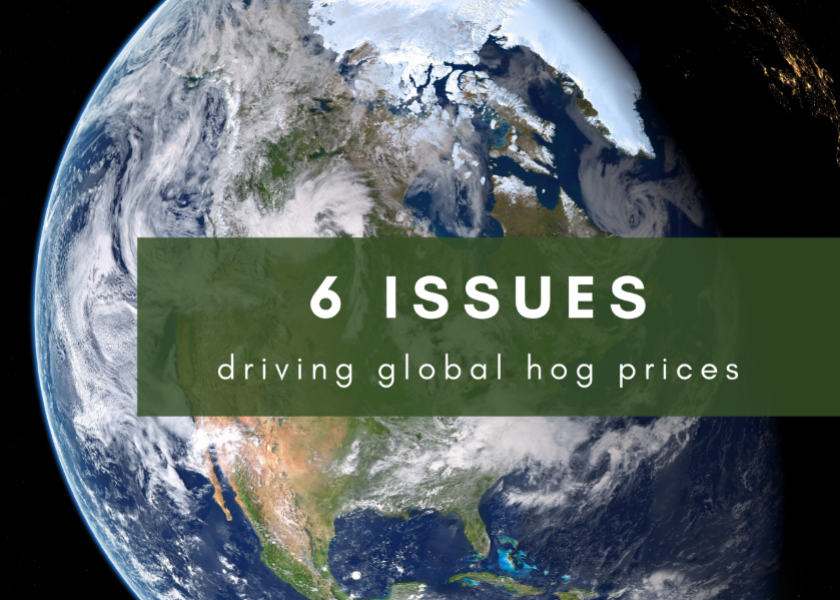6 Issues Driving Global Hog Prices

The global hog industry has had an interesting start to 2021, with expectations for slower production growth in many parts of the world. Rising herd health challenges, higher feed costs and demand uncertainty due to ongoing pandemic disruption have pressured margins, adding risk to global pork markets, explained Rabobank in its recent Pork Quarterly report.
All of this, combined with growing regulatory burdens and higher labor costs in the U.S., the Philippines and Europe, add even more uncertainty. Analysts said the net result is slower growth in global pork production which supports a rebound in hog and pork prices.
“The old adage that ‘it is sometimes better to be lucky than good’ could apply to global hog markets in 2021,” Rabobank said in its report. Analysts summarized six key issues driving prices this year.
1. Herd health challenges
Widespread herd health challenges are adding uncertainty to global pork markets from the re-emergence of classical swine fever (CSF) in Japan and Brazil to African swine fever (ASF) raging throughout parts of Asia and other regions. ASF is undoubtedly slowing herd rebuilding efforts in Asia and changing trade expectations for the rest of the world. In addition, larger herd losses than expected in China and the Philippines are increasing industry projections for exports. However, analysts warn rising shipping costs and higher pork prices could limit volumes sold. In addition, diseases like porcine reproductive and respiratory syndrome (PRRS) and porcine epidemic diarrhea virus (PEDv) are also impacting the supply of hogs in the U.S. and Mexico. All of this is expected to strain the supply chain in coming months, resulting in sharply higher prices.
2. Rising feed costs
On average, the price of feed and feed ingredients has jumped 35% higher year over year on average, analysts said. Feed costs are the largest variable cost for most producers, so regional differences in feed availability and supplies of reasonable alternatives can have a dramatic shift on production economics, Rabobank said. As well, countries that rely on imported feed have even more exposure to global shortfalls and price volatility. In China, herd rebuilding and increased commercial feed use is straining the global balance sheet. China’s corn imports rose 438% year over year, or roughly 20% of total global corn trade. Chinese officials are publishing guidelines limiting corn and soybean meal inclusion in hog diets, while incentivizing more local production. Many producers are shifting to alterative feeds, but those options are also limited. Rabobank says while higher feed costs are manageable in many systems, it will undoubtedly force producers to focus on feed conversions and could drive slightly lighter marketing weights in some markets. Analysts expect herd liquidation and slower production growth for higher-cost operators.
3. Mixed global demand recovery
Retail pork sales are strong in most markets, but a slower recovery in foodservice and group dining pose challenges for some higher-value and processed pork items. In countries like Japan and in parts of Europe, new dining and travel restrictions are being implemented to curb rising cases of COVID-19. Although lockdown measures are expected to be temporary, Rabobank said, it does create ongoing disruption on business and tourism. Pork sales could also struggle as food and fuel costs rise, stretching consumer dollars. Rabobank expects this to be worse in countries that have been slower to recover from COVID-19 or where economic challenges were present before the pandemic.
4. Strong Q1 imports
China’s pork imports through March were slightly ahead of expectations, up 22% year over year. Current trade flows support Chinese imports toward the upper end of Rabobank’s 3.5 million to 5 million metric ton estimate for pork and variety meat for the full year but remain subject to ongoing uncertainty. Analysts said this likely reflects China’s tight domestic balance sheet and buyers’ expectations for higher-cost pork in the months ahead. Exports from many destinations slowed in April due to the seasonal downturn in demand, increasing freight disruptions and resulting higher costs, as well as rising pork export prices.
5. Higher prices offset rising costs
Analysts noted that herd losses and efforts to curb production during the pandemic in 2020 and the new challenges of 2021 have helped slow growth in most regions. This is contributing to a sharp price recovery and a return to profitability. Even with some of the highest feed costs in nearly eight years and global trade muted, Rabobank said the industry has a relatively well-balanced supply and should be able to weather the storm. For those who can, analysts expect them to emerge from this cyclical low more resilient and prepared for stronger global demand post pandemic.
6. Cautious industry
The global hog production sector remains cautious. With ongoing supply challenges and limited visibility around demand, the industry has responded by slowing growth and in some cases, contracting supply. This improved balance will enable the sector to post better financial results than initially expected. Although there are areas of more economic stress such as Brazil and the Philippines, Rabobank said industry actions should help restore the product balance by the end of the year. All of these factors point to little rapid industry expansion in response to the rebound in profitability, the report said.
More from Farm Journal's PORK:
Profit Tracker: Cattle Squeeze Continues, Hog Margins Near Orbit
Air Pollution Study Contributes to False Animal Ag Narrative
March Beef, Pork Exports Hit Record Highs
African Swine Fever Vaccine Progress Takes Major Step Forward







